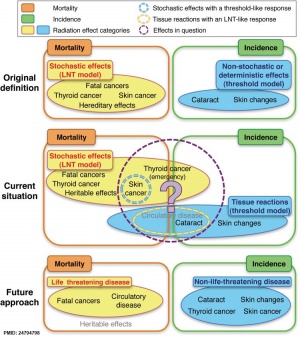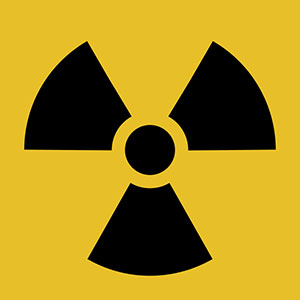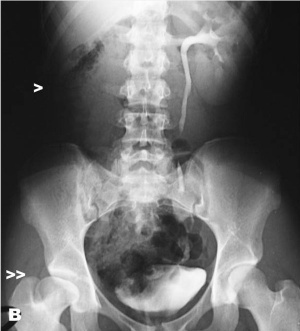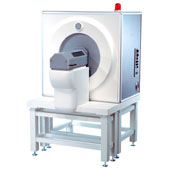Abnormal Development - Radiation
| Embryology - 28 Apr 2024 |
|---|
| Google Translate - select your language from the list shown below (this will open a new external page) |
|
العربية | català | 中文 | 中國傳統的 | français | Deutsche | עִברִית | हिंदी | bahasa Indonesia | italiano | 日本語 | 한국어 | မြန်မာ | Pilipino | Polskie | português | ਪੰਜਾਬੀ ਦੇ | Română | русский | Español | Swahili | Svensk | ไทย | Türkçe | اردو | ייִדיש | Tiếng Việt These external translations are automated and may not be accurate. (More? About Translations) |
Introduction
This page introduces the possible effects of radiation on development. The two main sources of exposure are environmental and those used for medical diagnostic or therapeutic purposes. The teratogenic effects of radiation were identified by Gilman Baetjer (1906)[1] and later by Bagg (1922).[2]
Studies have shown that in maternal X-ray diagnostic examination, where the beam does not irradiate the embryo/fetus directly (maternal skull and chest X-ray), the absorbed dose for the embryo or fetus is extremely low (less than 0.01 mGy). Treatment of hyperthyroidism with 131 Iodine in a pregnant woman is strictly contraindicated due to the effects on the developing embryonic thyroid gland.
| Historic Radiation |
|---|
| 1904 X-Rays | 1922 Radium Effects |

Some Recent Findings
|
| More recent papers |
|---|
|
This table allows an automated computer search of the external PubMed database using the listed "Search term" text link.
More? References | Discussion Page | Journal Searches | 2019 References | 2020 References Search term: Radiation Effects |Radiation Teratogen |
| Older papers |
|---|
| These papers originally appeared in the Some Recent Findings table, but as that list grew in length have now been shuffled down to this collapsible table.
See also the Discussion Page for other references listed by year and References on this current page.
|
Diagnostic Radiography
A recent Australian review study has shown minimal effects of standard diagnostic radiography underspecific conditions.[9]
- "The only adverse effect statistically proven at the dose levels associated with diagnostic radiation procedures is a very small increase in childhood malignancy, with an estimated increase of one additional cancer death per 1700 10 mGy exposures. The important exception was the risk to the fetal thyroid from radioiodine exposure after 12 weeks' gestation."
Dual X-ray Absorptiometry
These types of radiological studies can be carried out in osteoporosis examinations.
"The aim of the current study was to estimate the embryo/fetus radiation doses and risks associated with spinal and hip dual X-ray absorptiometry (DXA) scans performed on the pregnant mother."
"In conclusion, the embryo/fetus dose in bone density measurements of spine and femur using pencil beam DXA is lower than the average daily natural background in the United States of 8 mGy. The health provider can decide whether a DXA scanning is beneficial to a pregnant woman, taking into account the potential radiation risks to the embryo/fetus presented in the current study."
Damilakis J, Perisinakis K, Vrahoriti H, Kontakis G, Varveris H, Gourtsoyiannis N. Embryo/fetus radiation dose and risk from dual X-ray absorptiometry examinations. Osteoporos Int. 2002 Sep;13(9):716-22.
Computed Tomography
Computed Tomography or computed axial tomography (CAT or CT scan) began in 1970's using x-ray and a computer to produce images either as individual slices or reconstructed to give three dimensional (3D) views of specific anatomical regions or structures. While some standard x-ray examinations of the abdomen may not pose a serious risk, some abdominal and pelvic CT studies deliver greater amounts of radiation to a developing pregnancy.
- Links: Computed Tomography
International Commission on Radiological Protection
"Almost always, if a diagnostic radiology examination is medically indicated, the risk to the mother of not doing the procedure is greater than is the risk of potential harm to the fetus. Most nuclear medicine procedures do not cause large fetal doses. However, some radiopharmaceuticals that are used in nuclear medicine can pose significant fetal risks. It is important to ascertain whether a female patient is pregnant prior to radiotherapy."
"...Fetal doses below 100 mGy should not be considered a reason for terminating a pregnancy."
International Commission on Radiological Protection Pregnancy and medical radiation. Ann ICRP. 2000;30(1):iii-viii, 1-43.
"It should be also remembered that irradiation of the fetus in all trimesters of the pregnancy carries an increased risk of cancer in the newborn in the first or second decade of life and at therapeutic doses - or their significant fraction - this risk can be substantial. Therefore, in view of all mentioned factors termination of pregnancy may be considered. The decision should be based on careful estimation of the entailed risk to the fetus, which in turn requires calculation of the dose to conceptus by a qualified expert. The decision itself should be made by the women to be treated in consultation with their physician, partner and counsellor. Particularly difficult problems arise when radiotherapy is performed in a woman with early, undiagnosed pregnancy. The result is sometimes a massive irradiation of the conceptus in a period when malformations are easily induced (at or after 3 weeks post conception).
To avoid such unintentional irradiation it seems necessary to perform pregnancy tests to diagnose, or exclude the pregnancy before undertaking radiotherapy.
Therapy of hyperthyroidism with 131 Iodine in a pregnant woman is strictly contraindicated due to possibility of external irradiation of the foetus but mostly due to radioactive iodide crossing the placenta into the foetal circulation with subsequent uptake by its thyroid. The gland may well be destroyed by beta radiation from the nuclide taken up (131I). Therefore, other methods of treatment should be employed, if possible, until delivery." (Text extract from: ICRP Radiation and your Patient: A Guide for Medical Practitioners PDF document (17 pages, 142 kB)
Links: International Commission on Radiological Protection | Pregnancy and Pedical Radiation Powerpoint Slide set(1.3 Mb) | Radiation and your Patient: A Guide for Medical Practitioners PDF document (17 pages, 142 kB) |
Australia
Australia has a National Standard for Limiting Occupational Exposure to Ionising Radiation (1995, Republished March 2002). Published by the Australian Radiation Protection and Nuclear Safety Agency (ARPANSA) to promote practices which protect human health and the environment from the possible harmful effects of radiation. ARPANSA is assisted in this task by its Radiation Health and Safety Advisory Council, which reviews the publication program for the Series and endorses documents for publication, and by its Radiation Health Committee, which oversees the preparation of draft documents and recommends publication.
| Australian Occupational Radiation Dose Limits | |
|---|---|
| Effective dose limit1 | 20 mSv per year, averaged over a period of 5 consecutive calendar years |
| Effective dose limit in a single year1 | 50 mSv |
| Equivalent dose limit - lens of the eye | 150 mSv per year |
| Equivalent dose limit - skin | 500 mSv per year |
| Equivalent dose limit - hands and feet | 500 mSv per year |
| 1. The limits shall apply to the sum of the relevant doses from external exposure in the specified period and the 50-year committed dose from intakes in the same period. | |
| Based on Australian NOHSC1013 1995 | |
References
- ↑ Template:Ref-GilmanBaetjer1906
- ↑ Bagg HJ. Disturbances in mammalian development produced by radium emanation. (1922) Amer. J Anat. 30(1): 134-161.
- ↑ Hamada N & Fujimichi Y. (2014). Classification of radiation effects for dose limitation purposes: history, current situation and future prospects. J. Radiat. Res. , 55, 629-40. PMID: 24794798 DOI.
- ↑ Murase K, Murase J, Machidori K, Mizuno K, Hayashi Y & Kohri K. (2018). Nationwide Increase in Cryptorchidism after the Fukushima Nuclear Accident. Urology , , . PMID: 29751027 DOI.
- ↑ Grant EJ, Furukawa K, Sakata R, Sugiyama H, Sadakane A, Takahashi I, Utada M, Shimizu Y & Ozasa K. (2015). Risk of death among children of atomic bomb survivors after 62 years of follow-up: a cohort study. Lancet Oncol. , 16, 1316-23. PMID: 26384241 DOI.
- ↑ Morgan WF. (2016). Overview of ICRP Committee 1: radiation effects. Ann ICRP , 45, 9-16. PMID: 26635336 DOI.
- ↑ Wertelecki W. (2010). Malformations in a chornobyl-impacted region. Pediatrics , 125, e836-43. PMID: 20308207 DOI.
- ↑ Korpela H, Bly R, Vassileva J, Ingilizova K, Stoyanova T, Kostadinova I & Slavchev A. (2010). Recently revised diagnostic reference levels in nuclear medicine in Bulgaria and in Finland. Radiat Prot Dosimetry , 139, 317-20. PMID: 20142277 DOI.
- ↑ Lowe SA. (2004). Diagnostic radiography in pregnancy: risks and reality. Aust N Z J Obstet Gynaecol , 44, 191-6. PMID: 15191441 DOI.
Reviews
Yoon I & Slesinger TL. (2020). Radiation Exposure In Pregnancy. , , . PMID: 31869154
Yang B, Ren BX & Tang FR. (2017). Prenatal irradiation-induced brain neuropathology and cognitive impairment. Brain Dev. , 39, 10-22. PMID: 27527732 DOI.
Matzon JL, Lutsky KF, Ricci EK & Beredjiklian PK. (2015). Considerations in the Radiologic Evaluation of the Pregnant Orthopaedic Patient. J Am Acad Orthop Surg , 23, 485-91. PMID: 26116850 DOI.
Hamada N & Fujimichi Y. (2014). Classification of radiation effects for dose limitation purposes: history, current situation and future prospects. J. Radiat. Res. , 55, 629-40. PMID: 24794798 DOI.
De Santis M, Cesari E, Nobili E, Straface G, Cavaliere AF & Caruso A. (2007). Radiation effects on development. Birth Defects Res. C Embryo Today , 81, 177-82. PMID: 17963274 DOI.
Articles
Historic Articles
Gilman PR. and Baetjer FH. Some effects of the Röntgen rays on the development of embryos. (1904) Amer. Jour. Physiol. 10: 222-224.
Bagg HJ. Disturbances in mammalian development produced by radium emanation. (1922) Amer. J Anat. 30(1): 134-161.
Books
- National Research Council (US); National Academy of Sciences (US); Neel JV, Schull WJ, editors. The Children of Atomic Bomb Survivors: A Genetic Study. Washington (DC): National Academies Press (US); 1991. Available from: http://www.ncbi.nlm.nih.gov/books/NBK234260/
Search Pubmed
Search Pubmed: Abnormal Development Radiation
Terms
(based on Australian Standard - NOHSC:3022)
- Absorbed dose - the energy absorbed per unit mass by matter from ionizing radiation which impinges upon it.
- Accident - an unintended event which causes, or has the potential to cause, employees or members of the public to be exposed to radiation from which the individual doses or collective doses received do not lie within the range of variation which is acceptable for normal operation. An accident may result from human error, equipment failure or other mishap; it may require emergency action to save life or to safeguard health, property or the environment; it requires investigation of its causes and consequences and, possibly, corrective action within the program for control of radiation; and it may require remedial action to mitigate its consequences.
- Action level - an intervention level applied to exposure to radiation; when a public exposure action level is consistently exceeded, remedial action to reduce exposure should be considered; when an occupational exposure action level is consistently exceeded within a practice, a program of radiation protection should apply to that practice.
- Activity - the measure of quantity of radioactive materials (see Annex B), except when used in the term ‘human activity’.
- ALARA - an acronym for ‘as low as reasonably achievable’, used in the context of optimization.
- Alpha particle - a charged particle, consisting of two protons and two neutrons, emitted by the nucleus of a radionuclide during radioactive decay (α-decay).
- Annual Limit on Intake - (ALI) that quantity of a radionuclide which, taken into the body during one year, would lead to a committed effective dose equal to the occupational annual limit on effective dose.
- Approval - a written agreement by the appropriate authority that a plan or proposal meets the radiation protection requirements of the Recommendations.
- Beta particle - an electron or positron emitted by the nucleus of a radionuclide during radioactive decay (β-decay).
- Code of practice for radiation protection - a document prescribing specific requirements for radiation protection in a particular application.
- Collective effective dose - a measure of the total radiation exposure of a group of people which is obtained by summing their individual effective doses.
- Collective equivalent dose - a measure of the total radiation exposure of a specific organ type or tissue type in a group of people which is obtained by summing the equivalent doses received by those individual organs or tissues of the people exposed.
- Committed effective dose - the effective dose which a person is committed to receive from an intake of radioactive material.
- Committed equivalent dose - the equivalent dose which an organ or tissue is committed to receive from an intake of radioactive material.
- Controlled area - an area to which access is subject to control and in which employees are required to follow specific procedures aimed at controlling exposure to radiation.
- Critical group - a group of members of the public comprising individuals who are relatively homogeneous with regard to age, diet and those behavioural characteristics that affect the doses received and who receive the highest radiation doses from a particular practice.
- Deterministic effect - an effect, such as partial loss of function of an organ or tissue, caused by radiation and manifest only above some threshold of dose, the severity of the effect depending upon the dose received.
- Detriment - a measure, or measures, of harm caused by exposure to radiation and usually taken to mean health detriment; it has no single definition, but can be taken to be an attribute or a collection of attributes which measure harm, such as attributable probability of death and reduction of life expectancy.
- Dose - a generic term which may mean absorbed dose, equivalent dose or effective dose depending on context.
- Effective dose - a measure of dose which takes into account both the type of radiation involved and the radiological sensitivities of the organs and tissues irradiated (see Annex B).
- Electron - an elementary particle of mass 9.11 x 10-31 kg having a single negative charge.
- Equivalent dose - a measure of dose in organs and tissues which takes into account the type of radiation involved.
- Excluded exposure - in the context of occupational exposure, the component of exposure which arises from natural background radiation, provided that any relevant action level, or levels, for the workplace are not exceeded and that the appropriate authority does not prohibit its exclusion.
- Exposure - either the circumstance of being exposed to radiation, or a defined dosimetric quantity now no longer used for radiation protection purposes. (The context in which the word is used should avoid ambiguity.)
- Gamma ray - ionizing electromagnetic radiation emitted by a radionuclide during radioactive decay or during a nuclear (isomeric) transition.
- Guidance level for medical exposure - a reference level of dose or of administered activity likely to be appropriate for average-sized patients undergoing medical diagnosis or treatment.
- Half life - in relation to radioactive decay, the time required for the quantity of a radionuclide to decrease to one half of its initial value.
- Incident - an event which causes, or has the potential to cause, abnormal exposure of employees or of members of the public and which requires investigation of its causes and consequences and may require corrective action within the program for control of radiation, but which is not of such scale as to be classified as an accident.
- Intervention - action taken to decrease exposures to radiation which arise from existing situations.
- Ion - an atom in a charged state following ionization.
- Ionization - the process by which one or more electrons are removed from, or sometimes added to, an atom leaving the atom in a charged state.
- Ionizing radiation - radiation which is capable of causing ionization, either directly (for example: for radiation in the form of gamma rays and charged particles) or, indirectly (for example: for radiation in the form of neutrons).
- Justification - the notion that human activities which lead to exposure to radiation should be justified, before they are permitted to take place, by showing that they are likely to do more good than harm.
- Licence - a written authorization issued to an operator which allows the operator to carry out an operation legally.
- Limitation - the requirement that radiation doses and risks should not exceed a value regarded as unacceptable.
- Medical exposure - exposure of a person to radiation received as a patient undergoing medical diagnosis or therapy, or as a volunteer in medical research, or non-occupational exposure received as a consequence of assisting an exposed patient.
- Muon - an elementary particle of mass 1.88 x 10-28 kg having some properties similar to the electron; muons form a major component of cosmic radiation.
- Neutron - an elementary particle of mass 1.675 x 10-27 kg having some properties similar to the proton but carrying no charge; neutrons are constituents of all nuclei except for the stable isotope of hydrogen.
- Occupational exposure - exposure of a person to radiation which occurs in the course of that person’s work and which is not excluded exposure.
- Positron - an elementary particle of mass 9.11 x 10-31 kg having a single positive charge; the anti-particle of the electron.
- Practice - a type of human activity; in a radiological context, a human activity which may result in exposure to ionizing radiation and to which a system of radiation protection applies.
- Program of radiation protection - an instance of a system of radiation protection, designed for a particular operation.
- Proton - an elementary particle of mass 1.673 x 10-27 kg having a single positive charge; protons are constituents of all nuclei.
- Public exposure - exposure of a person, or persons, to radiation which is neither occupational nor medical exposure.
- Radiation - electromagnetic waves or quanta, and atomic or sub-atomic particles, propagated through space or through a material medium.
- Radiation weighting factor - a factor which modifies absorbed dose in an organ or tissue to yield equivalent dose and which is determined by the type and energy of the radiation to which the organ or tissue is exposed.
- Radioactive decay - the spontaneous transformation of the nucleus of an atom into another state, accompanied by the emission of radiation; for a quantity of such atoms, the expectation value of the number of atoms present decreases exponentially with time.
- Radioactive material - material which spontaneously emits ionizing radiation as a consequence of radioactive decay.
- Radionuclide - a species of atomic nucleus which undergoes radioactive decay.
- Radon - used generically, all isotopes of the element radon, having atomic number 86, but typically used to refer to the radioactive gas radon-222.
- Radon progeny - the short-lived products of the radioactive decay of radon, namely polonium-218, lead-214, bismuth-214, and polonium-214.
- Risk constraint - a restriction applied to potential exposure (see dose constraint).
- Specific activity - the activity of a radionuclide per unit mass of the element, or the activity of a radioactive material per unit mass of that material.
- Stochastic effect - an effect known to occur sometimes as a consequence of exposure to radiation, but which may or may not be expressed in a particular exposed person, the likelihood of the effect occurring being a function of the dose received.
- Supervised area - an area in which working conditions are kept under review but in which special procedures to control exposure to radiation are not normally necessary.
- System of radiation protection - a generic process of radiation risk management designed to limit the health risks arising from exposure to radiation to acceptable levels in a manner which takes economic and social considerations into account.
- Thoron - the radioactive gas radon-220.
- Thoron progeny - the short-lived products of the radioactive decay of thoron, namely polonium-216, lead-212, bismuth-212, polonium-212, and thallium-208.
- Tissue weighting factor - a factor which modifies equivalent dose in an organ or tissue to yield effective dose and which is the partial contribution from the organ or tissue to the total detriment resulting from uniform irradiation of the whole body.
- X-ray - ionizing electromagnetic radiation emitted during the transition of an atomic electron to a lower energy state or during the rapid deceleration of a charged particle.
| Radiation Terms (expand to view) |
|---|
| (based on Australian Standard - NOHSC:3022) |
|
| Other Terms Lists |
|---|
| Terms Lists: ART | Birth | Bone | Cardiovascular | Cell Division | Endocrine | Gastrointestinal | Genital | Genetic | Head | Hearing | Heart | Immune | Integumentary | Neonatal | Neural | Oocyte | Palate | Placenta | Radiation | Renal | Respiratory | Spermatozoa | Statistics | Tooth | Ultrasound | Vision | Historic | Drugs | Glossary |
External Links
External Links Notice - The dynamic nature of the internet may mean that some of these listed links may no longer function. If the link no longer works search the web with the link text or name. Links to any external commercial sites are provided for information purposes only and should never be considered an endorsement. UNSW Embryology is provided as an educational resource with no clinical information or commercial affiliation.
Glossary Links
- Glossary: A | B | C | D | E | F | G | H | I | J | K | L | M | N | O | P | Q | R | S | T | U | V | W | X | Y | Z | Numbers | Symbols | Term Link
Cite this page: Hill, M.A. (2024, April 28) Embryology Abnormal Development - Radiation. Retrieved from https://embryology.med.unsw.edu.au/embryology/index.php/Abnormal_Development_-_Radiation
- © Dr Mark Hill 2024, UNSW Embryology ISBN: 978 0 7334 2609 4 - UNSW CRICOS Provider Code No. 00098G



